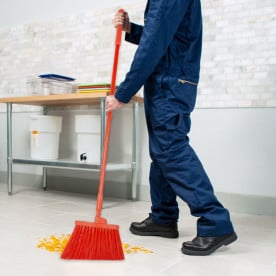Sanitation & Janitorial

- February 28, 2015
Welcome to the world of Ultra Safe Technology (UST), a groundbreaking line of brooms and brushes designed to revolutionize cleanliness in the food and beverage industry. UST goes beyond conventional cleaning tools by incorporating Bristle Security Units directly molded to the brush block, eliminating gaps and seams. Vikan introduces this innovative solution with a clear objective: to create the most secure, safe, and hygienic cleaning tools for food processors. Rigorous testing has ensured functionality, durability, and compliance with HACCP requirements and FDA regulations. Discover how UST enhances bristle security, ensures food safety, improves product quality, and boosts cleaning efficiency. With a commitment to hygiene, UST sets new standards for cleanliness, making it the ideal choice for those seeking a reliable and compliant solution in the realm of food processing.
- November 03, 2014
Here are some helpful tips to remember when using ice melt to prevent icy sidewalks and driveways.
Use It!
Whether it is in an effort to save money or time, skipping ice melt means that you are setting yourself up for slippery sidewalks, entryways and parking lots. This could be an expensive mistake for your company.
Don't Use Too Much
Evenly spread application is essential for optimal melt. Applying ice melt using a spreader ensures even application,
while scoops and shovels are most common, they can cause overuse or piling in areas.Know When To Apply
Todd Spencer, former National Sales Manager for North American Salt, is quoted saying "pre-application is ideal as an initial deterrent before the snow falls, though it is often difficult to predict necessity." Ice melt
- April 23, 2014
Welcome to our exploration of wet mops for cleaning and maintenance, brought to you by Nelson-Jameson. This comprehensive guide sheds light on different yarn materials, such as Cotton, known for its absorption and cost-effectiveness, and Rayon, prized for quick absorption and resistance to mildew. Discover the advantages of Cotton/Synthetic Blend, a harmonious fusion of performance and durability. The guide also delves into the distinction between Cut-End and Looped-End Mops, offering valuable insights into their characteristics, cost considerations, and longevity. Whether you're looking to understand the nuances of yarn materials or seeking guidance on mop types, our mop buying guide equips you with essential knowledge. Additionally, explore care and maintenance tips for maximizing the lifespan of your mop heads, and learn about the benefits of Color-Coded Mops in preventing cross-contamination. Enhance your understanding of yarn varieties and elevate your cleaning practices with Nelson-Jameson's
- April 23, 2014
Streamline your waste management process by exploring our comprehensive Container & Liner Buying Guide. Selecting the right liner and container is crucial to overcoming common challenges, such as liners that are either too small, falling into the can, or too large, resulting in unnecessary expenses and wasted plastic. Our guide not only provides valuable insights into choosing the correct liner size for your container but also offers an extensive overview of various bag types.Dive into the importance of knowing your container size and understanding the applications of different plastics—Linear Low Density Polyethylene (HDPE) for smooth materials and Linear Low Density Polyethylene (LLDPE) for rough and sharp materials. Discover the significance of gauge thickness and the nuanced measurements of Mil and Micron in evaluating liner strength. Empower yourself with the knowledge contained in our guide to make informed decisions for efficient waste containment and disposal. Explore
- April 23, 2014
In the realm of food processing, effective pest control stands as a paramount necessity to preempt costly shut-downs. Enter Insect-O-Cuter®, offering a meticulously designed three-phase system aimed at achieving optimal results in flying insect elimination within industrial settings. The first phase involves strategically placing units at the perimeter to intercept flying insects immediately after entry. The second phase introduces supportive Insect-O-Cutor® units along probable insect flight paths, protecting sensitive areas where contamination is a concern. The third phase places Insect-O-Cutor® units as a final interception outside crucial zones like processing and food preparation areas. The accompanying map guides the implementation of this comprehensive pest control strategy. Noteworthy considerations include the strategic placement of units in stairwells and elevators to address natural insect pathways. The provided FAQ section sheds light on various aspects, from the
- April 23, 2014
Selecting the right wheel and caster is vital for performance across various applications. Diverse wheel materials offer distinct advantages. Performa Rubber wheels, with a non-marking elastomer tread, provide a smooth, quiet, and durable ride. Duralastomer Polyurethane is a solid, durable option with a one-piece design, eliminating bonding failures. Glass Filled Nylon combines steel load capacity with high impact strength, washability, and steam cleanability. Polyolefin, light with superior impact strength, resists chemicals and protects floors. Phenolic wheels excel in quiet operation, floor protection, and resistance to impacts, chemicals, and steam. HiTech Polyurethane prevents debonding, offering chemical resistance and durability. Stainless Steel casters endure corrosive environments. Standard Duty handles up to 900 pounds with zinc-plated finish, double-hardened raceways, and versatile wheel options. General Utility casters, for medium-duty applications, handle up to 250 lbs with
- April 23, 2014
Employees can track in a myriad of potential contaminants and unknowingly put an operation at risk each time they breeze through a doorway to a production area. The effective use of a Disinfectant Mat™ provides a significant defense against cross-contamination. As employees step onto the mats, footwear is cleaned and sanitized. This barrier can help stop cross-contamination in its tracks.
Some plant managers complain that employees don't use them. Others say that they don't get cleaned out often enough or, the sanitizing solution loses effectiveness, creating a source of contamination. Yes, these things can happen but they don't have to, as each of these problems have a simple answer.
- April 23, 2014
Why Insulate?
- Prevent contamination from condensation dripping off pipes.
- Easier to keep pipes clean.
- Saves energy.
- Avoid employee burns.
- Better temperature control of process or CIP lines.
- Reduce noise.
- Improve appearance.
- April 23, 2014
Effectively caring for your cutlery can help maximize its performance and extend its life. Below is a list of our recommendations.
Hand Wash
After each use, carefully wash cutlery by hand with warm water and mild- to medium-strength soap; rinse and thoroughly dry with a soft towel.
Avoid Dishwashers
Knives should NOT be placed in automatic dishwashers. The blade edges can dull from rubbing against each other, and caustic detergents can cause staining and pitting of the blade.
Avoid Soaking
Cutlery should NOT be soaked for long periods or submerged for cleaning. Galvanic action, the transfer of electrons from one metal to another, may occur if cutlery is soaking in aluminum pans or stainless steel sinks, which can cause pitting on the blades.
Avoid Chlorine & Bleach Products
There is a tendency for chlorine and bleach products to discolor
- April 02, 2014
Now is the time to do annual maintenance on your insect electrocutor units. Late winter is the perfect time to check your insect units to make sure they are working properly, and to do an annual bulb change.
Here are two common questions to remember before spring insect hatchings happen:
My lamps are lit, why do I need to change them?
A lamp that is still lit may not be doing the job you need it to. Black light (UV) lamps are most effective when new. They lose their ability to attract insects long before they actually burn out. UV light is invisible and while the lamps remain lit the UV producing phosphor only has an effective life of 7000 hours or about 9 months.When should I change my bulbs?
It is essential to replace lamps at least annually. Most users choose to change their lamps in the spring, which is the beginning of the insect season. Each lamp comes standard with a year/date label for audit compliance, but also to







